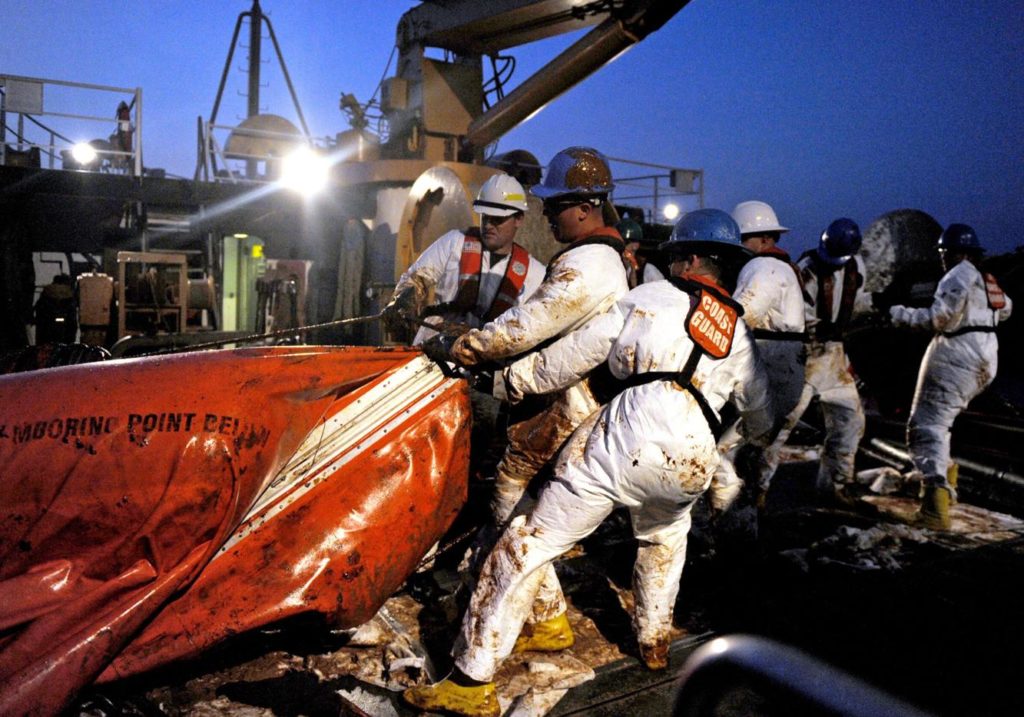
An envorionmental group uses a dispersant on an oil spill. It must be good to use. Right!
After almost 30 years of delays and a range of health and environmental concerns raised by scientists, a federal judge has ordered the U.S. Environmental Protection Agency to update its rules for the chemical dispersants that were used during BP’s Deepwater Horizon oil disaster. Judge William Orrick of the U.S. District Court in San Franciso agreed Monday with environmental groups that the update is long overdue. “I find that the EPA breached its non-discretionary duty to issue the final rule” and “delayed unreasonably” a process that scientists have been calling for since the mid-1990s, Orrick wrote. Orrick, an appointee of President Barack Obama, gave the EPA a May 31, 2023 deadline to update and finalize its rules. Citing past delays by the agency, Orrick also ordered the agency to file status updates every 180 days.

U.S. COAST GUARD PHOTO
Why now years after the use? New research always shows a new and better way and shows why the old way was wrong.
Over the past four years, a flood of new research has blamed dispersants for a host of problems, including lingering human health effects from the BP disaster more than a decade ago. “We are delighted, although not really surprised, with the court’s finding that oil spill response regulations enacted more than 15 years before the BP Deepwater Horizon disaster are no longer aligned with current science and technology,” said Sumona Majumdar, a lawyer for Earth Island Institute, one of the groups that sued the EPA last year. “We urge the EPA to quickly issue a final rule that properly regulates these dangerous chemicals.” An EPA spokesperson said the agency is reviewing the decision but would not comment further.

How does a dispersant work? What makes it effective? Is there a down side?
Rather than clean up oil, dispersants break it into droplets that more easily mix with water. Dispersants have been used during 27 spills in the U.S. over the past 40 years, and most of those were in the Gulf of Mexico, according to the National Oceanic and Atmospheric Administration. During the Deepwater Horizon disaster, almost 1 million gallons of dispersant was sprayed by air, and another 770,000 gallons were injected into the damaged wellhead on the sea bottom. The well released about 134 million gallons of oil over 87 days. The lawsuit was filed on behalf of several groups and individuals who say people and the environment were harmed by dispersants in Louisiana during the BP disaster and in Alaska after the 1989 Exxon Valdez wreck. Plaintiffs include Plaquemines Parish commercial fisher Kindra Arnesen. “Dispersant use in the wake of the BP spill took a huge toll on my community,” said Arnesen, who said the rates of cancer and other illnesses increased after the disaster. “I went to 22 funerals in 18 months. Then I stopped counting.”
If dispersants are this bad, why were they used? Wasn’t there a better way?
Studies of dispersant use haven’t shown a direct link with cancer, but they have indicated several reasons for concern. Recent studies have indicated dispersants caused lung irritation, rashes, nausea and other illness in U.S. Coast Guard members and other Deepwater Horizon responders. They also cause problems for fish, deep-sea coral and other marine life. Dispersants can kill or inhibit the growth of oil-eating microbes, weakening nature’s ability to clean up spills. Research also indicates that dispersants can have the unintended effect of transforming oil into a toxic mist able to travel for miles and penetrate deep into human lungs. In 2019, the National Academies of Sciences weighed in, stressing that dispersants should remain a tool for halting the spread of oil. But they also urged the EPA and other response managers to analyze the trade-offs of dispersants against other options. Orrick echoed the need for updated information in a related ruling last year. He determined that the U.S. Clean Water Act requires the EPA periodically to review and update its spill response plan with new information, something the EPA hasn’t done since 1994. “We need smart spill responses that use the best available science,” said Kristen Monsell, a legal affairs director for the Center for Biological Diversity, another plaintiff. “Oil spills are bad enough. We can’t have the EPA adding insult to injury by allowing the use of harmful chemicals afterward that put wildlife and people at even more risk.”

PHOTO BY JONATHEN DAVIIS, U.S. COAST GUARD
So we may have a new way fo fighting oil spills and with these Coast Guard photos they will be one of beneficiaries. All of will if we come in contact with those cleaning up the spills.



